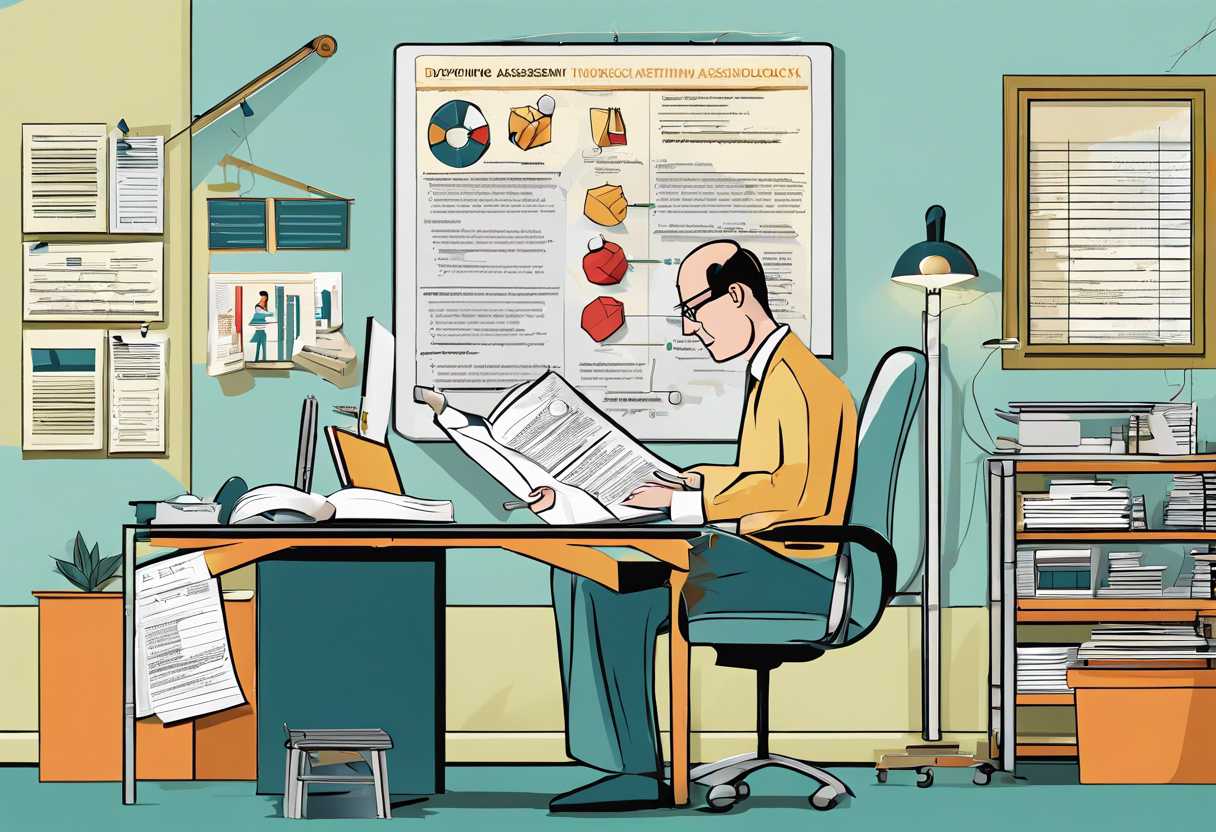Are you looking to create a comprehensive risk assessment report but not sure where to start? In this blog post, we will guide you through the process of drafting a risk assessment report, covering key aspects such as understanding the purpose and scope, identifying potential risks, developing a methodology, documenting findings, and implementing risk mitigation strategies. By the end of this post, you will have a clear understanding of how to effectively draft a risk assessment report that meets the needs of your organization. So, let’s dive in and explore the essential steps to create a robust risk assessment report.
Understanding the Purpose and Scope of a Risk Assessment Report
The Importance of Risk Assessment Reports
Risk assessment reports are crucial tools for businesses and organizations to identify, evaluate, and prioritize potential risks that could impact their operations. These reports provide a comprehensive analysis of potential hazards, vulnerabilities, and threats, allowing stakeholders to make informed decisions to mitigate and manage risks effectively. By understanding the purpose and scope of a risk assessment report, businesses can proactively address potential issues and safeguard their assets, reputation, and stakeholders.
Key Components of a Risk Assessment Report
A well-structured risk assessment report typically includes an executive summary, methodology, findings, and recommendations. The executive summary provides a concise overview of the report’s key findings and recommendations, while the methodology outlines the approach and tools used to assess risks. The findings section presents the identified risks, their potential impact, and likelihood, while the recommendations offer actionable steps to address and manage these risks. Additionally, the report may include a risk register, which lists all identified risks along with their corresponding risk ratings and mitigation strategies.
Benefits of Conducting a Risk Assessment
Conducting a risk assessment not only helps organizations identify potential threats but also enables them to prioritize and allocate resources effectively. By understanding the likelihood and impact of various risks, businesses can focus on addressing high-priority risks that could have a significant impact on their operations. Furthermore, risk assessment reports facilitate communication and transparency within an organization, as they provide a clear overview of potential risks and the recommended actions to mitigate them. Ultimately, a well-executed risk assessment can help businesses enhance their resilience and adaptability in the face of uncertainty.

Identifying and Analyzing Potential Risks in the Workplace
The Importance of Risk Identification
Identifying potential risks in the workplace is crucial for maintaining a safe and productive environment for employees. By recognizing and understanding these risks, employers can take proactive measures to mitigate them and prevent accidents or injuries. This not only protects the well-being of employees but also helps to avoid costly legal issues and damage to the company’s reputation.
Common Types of Workplace Risks
There are various types of risks that can exist in a workplace, including physical hazards, ergonomic hazards, chemical hazards, and psychosocial hazards. Physical hazards may include slippery floors or falling objects, while ergonomic hazards could involve repetitive movements or uncomfortable workstations. Chemical hazards may arise from exposure to harmful substances, and psychosocial hazards could stem from workplace stress or bullying. It’s important for employers to be aware of these different types of risks and take appropriate measures to address them.
Steps for Analyzing Workplace Risks
When analyzing potential risks in the workplace, it’s essential to follow a systematic approach. This typically involves identifying hazards, assessing the risks associated with each hazard, and implementing control measures to minimize or eliminate those risks. Employers can use tools such as risk assessment matrices or checklists to help with this process. By conducting thorough risk analysis, employers can prioritize the most significant risks and allocate resources effectively to manage them.

Developing a Comprehensive Risk Assessment Methodology
The Importance of a Comprehensive Risk Assessment Methodology
When it comes to managing risk within an organization, having a comprehensive risk assessment methodology is crucial. This methodology allows businesses to identify, analyze, and prioritize potential risks, ultimately helping them make informed decisions to mitigate these risks. By developing a comprehensive risk assessment methodology, organizations can proactively address potential threats and opportunities, leading to better overall risk management.
Key Components of a Comprehensive Risk Assessment Methodology
There are several key components that should be included in a comprehensive risk assessment methodology. These components may include:
- Identification of potential risks
- Analysis of the likelihood and impact of each risk
- Prioritization of risks based on their potential impact
- Development of risk mitigation strategies
- Regular review and updating of the risk assessment methodology
Implementing a Comprehensive Risk Assessment Methodology
Implementing a comprehensive risk assessment methodology involves a series of steps and procedures. This may include:
- Establishing a risk assessment team
- Identifying and documenting potential risks
- Conducting a thorough analysis of each risk
- Assigning a likelihood and impact rating to each risk
- Prioritizing risks based on their ratings
- Developing and implementing risk mitigation strategies
- Regularly reviewing and updating the risk assessment methodology
Documenting and Communicating Findings in the Risk Assessment Report
The Importance of Clear Documentation
One of the most critical aspects of a risk assessment report is the clear and thorough documentation of findings. This documentation serves as a record of the assessment process, the identified risks, and the recommended actions to mitigate those risks. Clear documentation is essential for ensuring that all stakeholders understand the findings and can take appropriate action.
Effective Communication of Findings
Once the findings have been documented, the next step is to effectively communicate those findings to the relevant parties. This may include senior management, department heads, or other key decision-makers. Effective communication involves presenting the findings in a clear and concise manner, highlighting the most critical risks, and providing actionable recommendations for addressing those risks.
Utilizing Visual Aids for Clarity
In addition to clear documentation and effective communication, visual aids can be incredibly helpful in conveying the findings of a risk assessment report. Tables, charts, and graphs can help to illustrate the data and make it easier for stakeholders to understand the key findings. Visual aids can also help to highlight trends, patterns, and areas of particular concern, making it easier for decision-makers to prioritize their response.
Implementing and Monitoring Risk Mitigation Strategies
Identifying Potential Risks
Before implementing any risk mitigation strategies, it is crucial to first identify potential risks that could impact your business. This involves conducting a thorough risk assessment to determine the likelihood and potential impact of various risks, such as financial, operational, and strategic risks. By understanding the specific risks your organization faces, you can develop targeted mitigation strategies to address them.
Developing Risk Mitigation Strategies
Once potential risks have been identified, the next step is to develop risk mitigation strategies to minimize their impact. This may involve implementing controls and safeguards to reduce the likelihood of risks occurring, as well as developing contingency plans to address risks if they do materialize. It is important to involve key stakeholders in the development of these strategies to ensure buy-in and alignment with organizational goals.
Monitoring and Adjusting Strategies
Implementing risk mitigation strategies is not a one-time event, but an ongoing process that requires regular monitoring and adjustment. This involves tracking key risk indicators to assess the effectiveness of mitigation strategies and making adjustments as needed. By continuously monitoring and evaluating the success of risk mitigation efforts, organizations can ensure that they remain agile and responsive to changing risk landscapes.
Conclusion
As we conclude our discussion on how to draft a risk assessment report, it is essential to emphasize the critical role of this document in ensuring workplace safety and security. Understanding the purpose and scope of the report sets the foundation for a comprehensive assessment, enabling organizations to identify and analyze potential risks effectively. Developing a robust risk assessment methodology and documenting findings in a clear and concise manner are crucial steps in the process.
Furthermore, effective communication of the report’s findings is essential for stakeholders to understand the identified risks and the proposed mitigation strategies. Implementing and monitoring these strategies is vital for ongoing risk management and maintaining a safe work environment.
It is important to remember that risk assessment is an ongoing process, and regular reviews and updates to the report are necessary to address new risks and changes in the workplace environment. By following the guidelines outlined in this blog post, organizations can draft a comprehensive risk assessment report that serves as a valuable tool in mitigating potential hazards and ensuring the well-being of employees.
For more information on risk assessment and workplace safety, feel free to reach out to our team of experts. We are here to support you in creating a safe and secure work environment for your organization.
Thank you for reading, and we hope this blog post has provided valuable insights into the process of drafting a risk assessment report.

